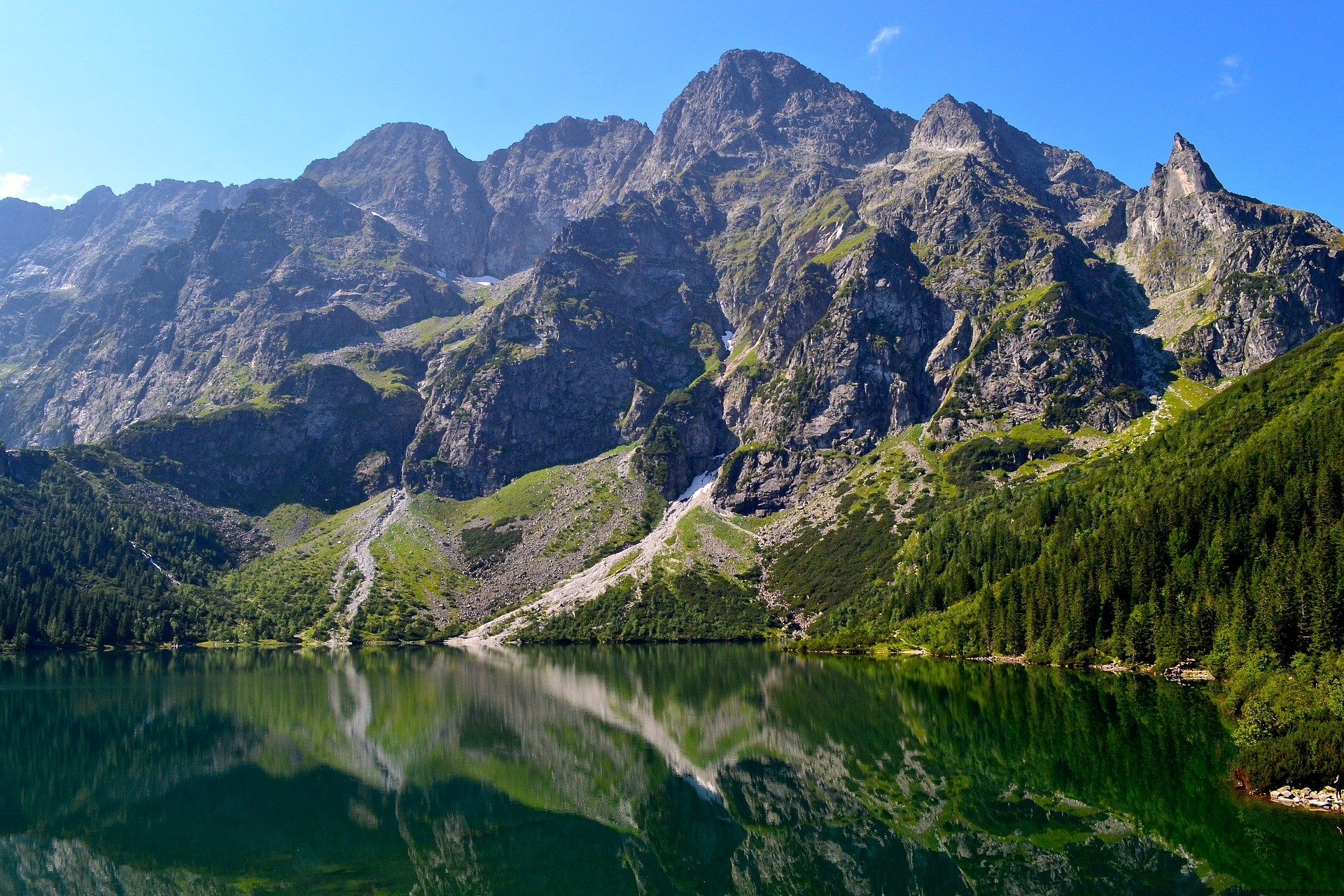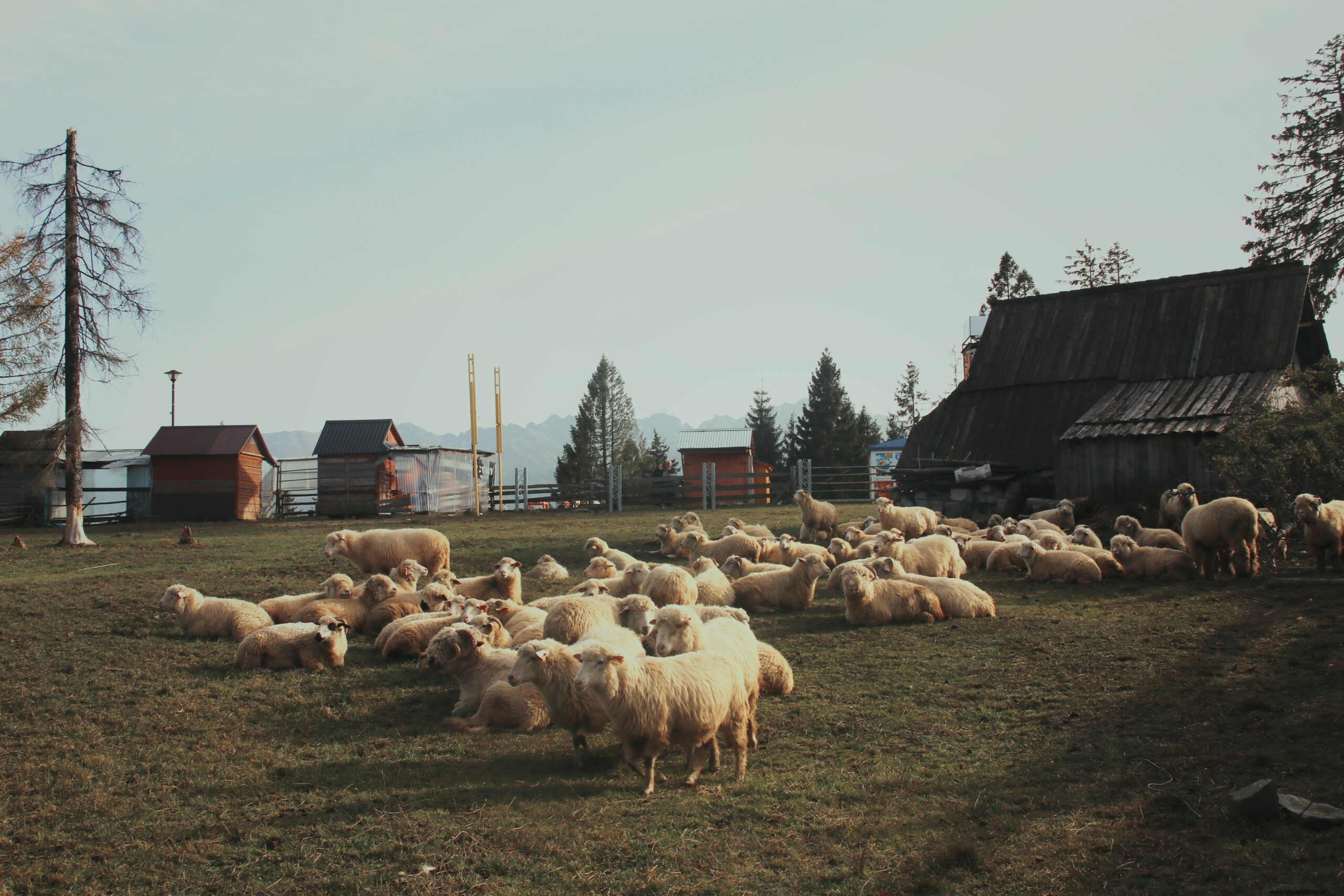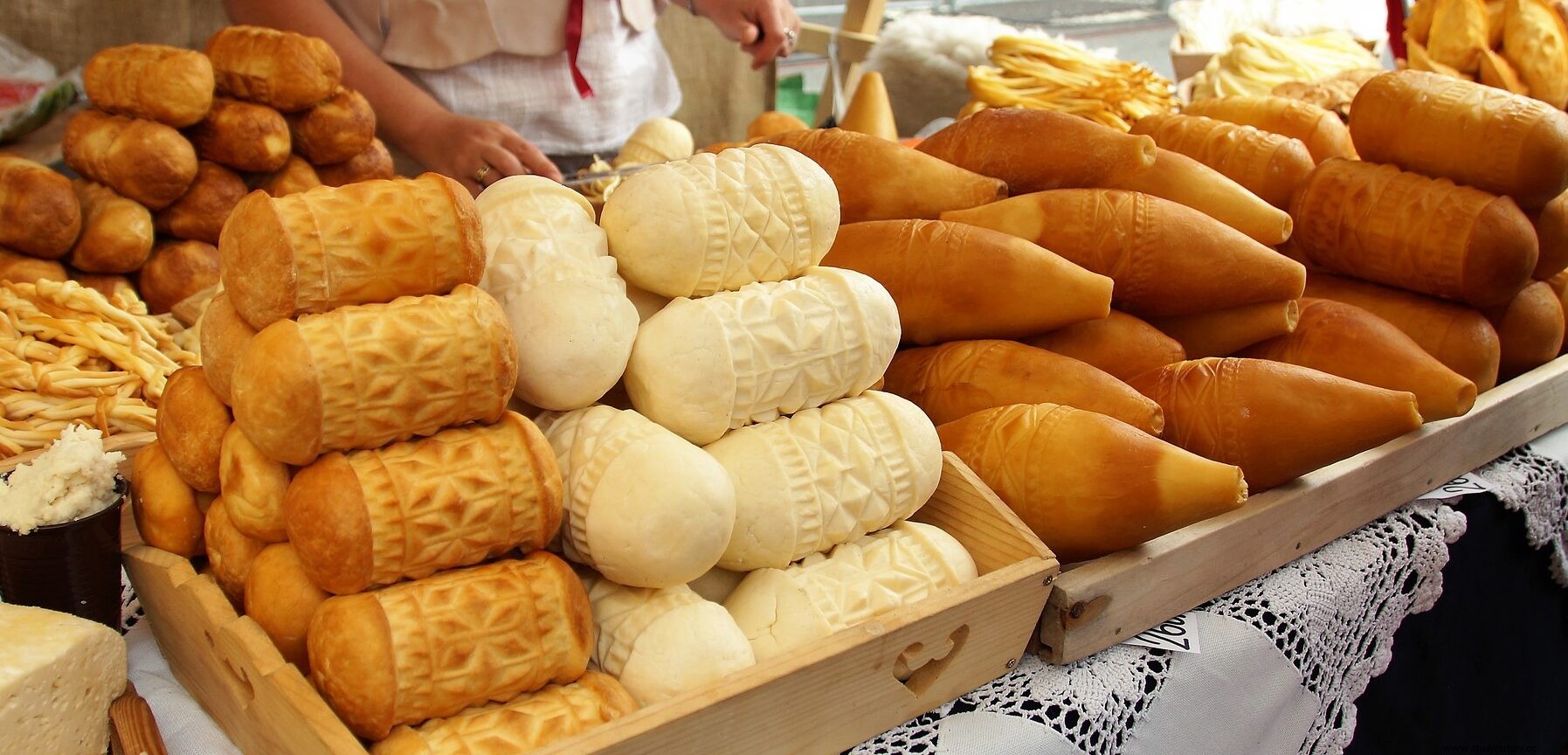Most of us are familiar with French, Italian, English, Dutch and even American Triangle cheeses, but have you ever heard of a traditional Polish cheese?
Let me introduce you to a craft and rare type of cheese called Oscypek (pronounced:os-tseh-pehk). It is a local type of semi-solid, salty and smoked cheese made from sheep's milk in the Podhale region of Poland. This region is located in the absolute southern part of the country, and it is more often referred to as the Polish highlands, as it is located just below the Tatra Mountains, part of the Carpathians. These mountains create a natural border between Poland and Slovakia and are home to the Polish highland sheep as well as the master cheese makers called Baca (pronounced:ba-tsa).
Zakopane, a town in the Podhale region, is a favorite tourist destination, especially in winter. As a result, this city is sometimes called even Poland's winter capital. The reason I mention Zakopane is that oscypek, the cheese, is widely available for sale in the markets of Zakopane. Also, this is where I first tried this delicious cheese and immediately fell in love with both the cheese and the destination.

The history of Oscypek
The history of the cheese goes back to 15 th century as it was when the manufacturing procedure was documented.
Semi-nomadic people from the Wallachian / Vlach tribe, from present-day Romania, once wandered around the Carpathians with their sheep, the Wallachian Zackels. They soon began to settle in the Podhale region. They quickly mingled with the native population by sharing their customs, beliefs, and even language. Their sheep also adapted well to these heights and unique climatic conditions thanks to their dense wool fur that would protect them from harsh conditions. It is estimated that this tribe settled between the 12 th and 15 th centuries. Since then, sheep have played an integral role in securing their livelihood because of their usefulness. Some were useful as meat, while some for clothing such as mattresses, pillows, blankets, blankets, etc. and some for dairy products such as local cheese. Their usefulness and value have thus shaped not only their economy, but also the highlands' cultural heritage. It is interesting to note that oscypek was initially not only a great way to preserve high-protein foods for the winters, but it was also used as a form of currency. Tenants of the land had to pay a mandatory fee to their landowners for a certain number of cheeses. The number of cheeses to pay will depend on the size of the herd the shepherds own.
Production and tradition
The method of producing oscypek has not changed since the beginning. It still uses only two main ingredients:milk and rennet. Traditionally, this cheese is made only from sheep's milk obtained from sheep in the Podhale region. But over the years, it has become acceptable to mix a small amount of cow's milk weaned only from the Polish red cow. However, according to the guidelines for oscypek, the proportion of sheep's milk can not be lower than 60%.
To make the cheese, shepherds wait for ewes to enter the lactation period, which lasts for about 150 days from May to September. That's why this type of cheese is so rare.
On average, the sheep will produce 60-70 liters of milk per day. They are usually milked only in the morning, but during high periods they are also milked in the evening. This milk is extracted to process it into cheese. The temperature of the climate and the feed available to the sheep greatly affect the crop, the quality and the taste of the milk. As such, shepherds take extra care of their diet and well-being.

After extraction, the milk is brought to a wooden hut called bacówkas (pronounced:baa-tsoov-kah) to be heated over wood burning in a large pot, often made of copper. Bacówkas are cabins dedicated to making oscypek. This is where the bacas spend time in the summer. Although the cabins look worn from the outside, they are hygienic and clean on the inside, making it a clean place to handle edible products.
Then add rennet to the heated milk. This rennet is usually pulled out of the stomach of a calf and coagulates the milk solids to form curd to make the cheese. The curd is then mixed with a wooden tool to separate them from the whey. Strain this mixture with a cheesecloth and squeeze the curd. Then knead the curd block by hand in hot water until it is flexible to work with. The excess whey is pressed off by hand before the cheese is formed. Then a traditional wood mold printed with classic diamond-shaped patterns is used to shape the cheese. To make the traditional spindle-shaped cheese, first form a cylindrical shape by hand, then attach the shape to the center of the cylinder and enclose it, while the sides are shaped into cones. The end result is a spider-like shape with patterns in the middle.
The mold cheeses are then cooled in cold water, then they are soaked in salt water for approx. 24 hours. The next process is to let the air dry outside the cabin, and once tried, they are placed just below the roof of the cabin to smoke. The smoke formed from the wood fire in the hut puts the final touch to the cheese. The end product is a semi-solid cheese with an evenly pale golden / golden brown appearance with a heavenly scent.
The process of producing this particular cheese is ancient and has been passed down for generations. From one generation of bacas to the next. Traditionally, secret techniques are usually passed on to the male members of the family. But women have also gradually begun to learn and master the art of cooking cheese due to the limited stock of bacas and also due to the limited number of men who are willing to continue this tradition. In this era, the demand for traditional products is limited. Therefore, it is easy for such arts to lose their relevance. But as part of the region's cultural identity, it is crucial to preserve it. Therefore, steps such as the participation of women in cheese production and the preservation of bacówkas for rural tourism are steps to preserve the local culture of the highlands.
Cultural and economic significance
When discussing oscypek, it is impossible to neglect the sheep that provided the resources to produce it. So really, the sheep are the heroes here. Although sheep dairy products are most important in the mountain areas, mutton from the Podhale region is in demand both domestically and internationally, as is wool and leather for clothing.
Culturally, sheep grazing is part of the local folklore that appreciates and values the bond between animals and humans. Once a year, pastoralism is celebrated where the shepherds perform rituals and formalities related to sheep breeding.
As for oscypek itself, they serve as starters at local social gatherings such as gatherings, weddings and more. Medium to thick slices of cheese are cut and eaten as they are with a serving of either beer or vodka. In addition, the patterns on oscypek have even influenced architects to use them in their designs. All indications are that it is actually integrated into the local culture.
Trade
The shepherds and other sellers in the locality come down to larger cities to sell their products. This is where Zakopane becomes relevant. Various local products are sold at the local street markets, such as the one on Krupowki Street in Zakopane. These stalls are set up and display a diverse selection of bright, colorful and edible products. Ranging from garments such as traditional dresses, coats, sweaters, boots, socks, sweaters, slippers, blankets, etc. to a variety of local highland cheeses. There are a number of cheeses that vary in size, shape, color, patterns, smokyness, cheeses made from cow's milk or a mixture of cow's and sheep's milk, etc.
Please note that oscypek is not the only type of highland cheese available in the region. However, it is the only cheese in the region whose taste is pleasing to the general palate.
Here we can buy products made with so much patience and hard work. We can either buy them whole or try smaller portions of the cheese on the spot.

Sampling of cheese
While trying oscypek in the street markets, you will probably be served grilled and hot with cranberry jam on the side with a toothpick or wooden skewer when you are on the go on small paper trays. They are usually cut into medium-thick slices or a smaller flat oval version of the cheese is served.
The aromas tease your senses, the smoke is indescribable. When you bite into it, you realize that the outside is still firm, but the inside is sticky and delicious. The tasty taste hangs on your tongue while the smoke encourages you to keep eating. Although it is sticky on the inside, its spongy and resilient texture makes it possible to chew it. It can almost be compared to rubber, but not in a negative sense. It is this unique texture that makes it such a special product. There's just nothing like it.
The sour jam balances out the fatness of the cheese, while the combination of salt and smoke enhances the rich taste of the milk. It's been over 8 years since I tried it, and I can still remember the taste every time I think about it.
Although it is usually served hot, it does not need to be served that way. Cold oscypek, however, is firmer and more rubbery, but still delicious. I personally prefer hot oscypek with jam. They really are a match made in heaven. Some sources say that this combination is not traditional, it is definitely delicious enough to be a popular choice.
Finally, from the sheep to the cultural traditions of the stunning landscape to the sale of traditional and locally produced handmade crafts, they combine their values to attract tourists who ultimately help the region financially. This generates revenue for local suppliers, farmers, shepherds and innkeepers.
Oscypek today
Due to the properties, texture and taste of the cheese, it is not added to any known dishes. In addition, its richness and fat content make it an incredibly difficult food to digest. It would make any dish very heavy. Due to difficulties in digesting it, children are advised not to eat it. As such, it is not yet known to be used as an ingredient in local dishes.
In 2008, Oscypek received a PDO certificate (protected designation of origin). This recognizes a product from a particular region to protect the origin and identity associated with the culture there. It legally protects the name and method of production of the product from counterfeiting, mass production and piracy of the product. As such, the certification only recognizes oscypek as it is if it is made by hand, if it used at least 60% Polish highland sheep milk, often the other 40%, if mixed at all, must be milk from the Polish red cow, treated without use of modern machinery or any kind of modern technology and most importantly only if it is made in the Podhale region.
Variations
Since the Tatra Mountains are divided between Poland and Slovakia and since the highland sheep belong to that region, I wondered if the Slovaks had similar cheeses or not. As expected, they do! They also have different types of mountain cheese. However, Slovenský Oštiepok looks strikingly like the Polish Oscypek. The Slovak counterpart is made from sheep's and / or cattle's milk from that region, and they even have similar patterns and shapes to the Polish ones. After some reflection, I realized that even their names sound like Oscypek (os-tseh-pehk) and Oštiepok (osh-tchyeh-pok).
In summary, oscypek cheese is a valued product from Poland and Zakopane, and even the entire Podhale region is worth exploring. I strongly recommend that you visit these a little outside the usual destinations, if possible. Finally, I would like to end by encouraging all readers to embrace their adventurous side, especially when it comes to food. It is understandably difficult to get out of the comfort zone and taste foreign flavors even when traveling. But with this limitation, you can miss out on so much, maybe even an experience of a lifetime. It is important to understand that tasting new food is not just about taste and flavor, but also the willingness to dig deep into the culture and learn about the local community. It is an important anthropological element that provides details about geography and landscape, tells history and teaches customs and formalities. So next time, be brave and go to a local restaurant or eatery that serves local food.
Bibliography
Kasprzyk-Chevriaux, M., 2014. Polish with 101. [Online]
Available at: https://culture.pl/en/work/polish-food-101-oscypek
[Accessed 27 February 2021].
Kawęcka, A. &Krupiński, J., 2014. CABINET IN THE POLISH CARPATIES:GENETIC RESOURCES CONSERVATION OF PODHALE ZACKEL AND COLORED MOUNTAINS. Geomatics, land management and landscape, 1 (1), pp. 35-45.
Museum Oscypka Zakopane, nd Meet Oscypka. [Online]
Available at: https://www.muzeumoscypka.pl/oscypek/poznaj-oscypka
[Accessed 27 February 2021].
Slow Food Foundation for Biodiversity, nd Treg mat. [Online]
Available at: https://www.fondazioneslowfood.com/en/slow-food-presidia/oscypek/
[Accessed 27 February 2021].
Taste Atlas, nd Taste Atlas. [Online]
Available at: https://www.tasteatlas.com/slovensky-ostiepok/
[Accessed 27 February 2021].
The Great Big Story, 2018. Youtube. [Online]
Available at: https://www.youtube.com/watch?v=CMUF9f1veLw
[Accessed 27 February 2021].
Zakopane Cultural Center, nd Kasprowy Wierch cable car. [Online]
Available at: https://www.zakopane.pl/en/tourist-area/tourism/mountain-ropeways/kasprowy-wierch-cable-railway
[Accessed 27 February 2021].
Zakopane.com, 2019. Time for Oscypek. [Online]
Available at: https://zakopane.com/en/time-for-oscypek/
[Accessed 2 February 2021].
